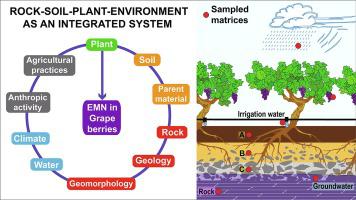Catena ( IF 6.2 ) Pub Date : 2020-09-11 , DOI: 10.1016/j.catena.2020.104905 Pamela Castillo , Ignacio Serra , Brian Townley , Felipe Aburto , Sofía López , Joseline Tapia , Muriel Contreras

|
Essential mineral nutrients are key elements for the development and production of grapevines. Under natural conditions most nutrients have a lithogenic origin, however, in agroecosystems their contents and distribution can be greatly altered by anthropogenic additions. To assess the origin and contribution of lithogenic and anthropogenic nutrient sources, we studied the rock-soil–water-fruit interfase in four vineyards of Central Chile located in the sites of Casablanca, San Antonio, Santa Cruz and San Javier, which are characterized by contrasting geological, geomorphological, and mesoclimatic conditions as well as the magnitude of anthropogenic influence.
Detailed mapping and soil characterization were carried out at each vineyard. Additionally, parent rock, soil, berries, rain, irrigation water and groundwater were sampled and the distribution and behavior of P, K, Ca, Mg, Fe, Mn, Zn, Cu, and Na were studied. For berries, others elements such as N, S, B and Cl were considered.
The geochemistry of soils was concordant with its lithological origin. However, Zn and Cu were dominantly anthropogenic due to atmospheric deposition and the use of agrochemicals. This was evidenced by their greater bioavailability in topsoil and by the chemistry of irrigation and rainwater. Across sites, berries displayed similar nutrient patterns by cultivar; K and S were concentrated in cv. Carmenere, while Ca, Mg and P were enriched in the cv. Pinot Noir. However, Fe, Mn, Zn and Cu had a particular distribution at each plot, reflecting the unique interaction between environment, lithology, soil properties and viticultural practices. Factor Analysis showed a good correlation between soils and berries for K and ± Na, Fe, Cu and Mg, which implies that soil composition was reflected in the composition of the berries.
Since geochemical, geological and environmental influences on the chemistry of berries were recognized, it is proposed that interdisciplinary critical zone studies should be undertaken to improve the sustainability of vineyard management strategies.
中文翻译:

智利中部葡萄园中横跨岩石,土壤,水和水果的植物必需矿物质营养素的生物地球化学
必需的矿物质营养素是葡萄树发展和生产的关键要素。在自然条件下,大多数营养素都具有成岩作用,但是在农业生态系统中,人为添加会大大改变其含量和分布。为了评估成岩作用和人为营养源的来源和贡献,我们研究了智利中部四个葡萄园的岩土-水-水果界面变化,这些葡萄园位于卡萨布兰卡,圣安东尼奥,圣克鲁斯和圣哈维尔,其特点是对比地质,地貌和中气候条件,以及人为影响的程度。
在每个葡萄园进行了详细的测绘和土壤特性分析。此外,还对母岩,土壤,浆果,雨水,灌溉水和地下水进行了采样,并研究了P,K,Ca,Mg,Fe,Mn,Zn,Cu和Na的分布和行为。对于浆果,考虑了其他元素,例如N,S,B和Cl。
土壤的地球化学与其岩性起源是一致的。但是,由于大气中的沉积物和农药的使用,锌和铜是主要的人为来源。它们在表土中的较高生物利用度以及灌溉和雨水的化学作用证明了这一点。在各个地点,浆果显示出不同的栽培品种养分模式。K和S集中在cv中。Carmenere,而Ca,Mg和P则富含cv。黑比诺。然而,铁,锰,锌和铜在每个样区都有特定的分布,反映了环境,岩性,土壤性质和葡萄栽培实践之间的独特相互作用。因子分析显示土壤和浆果之间的钾和±Na,Fe,Cu和Mg有良好的相关性,这表明土壤成分反映在浆果的成分中。
由于人们认识到地球化学,地质和环境对浆果化学的影响,因此建议应开展跨学科的关键区研究,以提高葡萄园管理策略的可持续性。



























 京公网安备 11010802027423号
京公网安备 11010802027423号